#Cleveland Public Schools
Explore tagged Tumblr posts
Text
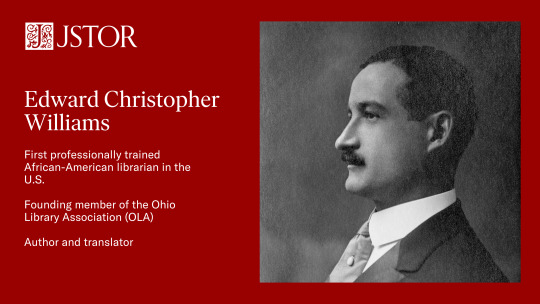
Edward Christopher Williams (11 Feb. 1871 - 24 Dec. 1929) was a pioneering African American librarian, educator, and scholar who played a vital role in shaping library collections at Western Reserve University (WRU) and Howard University. Born in Cleveland to Daniel P. Williams, a prominent African American figure, and Mary Kilkary Williams, a Clevelander of Irish descent, Williams embarked on a remarkable journey of academic and professional achievement.
Graduating from Adelbert College of WRU in 1892, Williams quickly made his mark as he assumed the role of first assistant librarian at the institution. His dedication and expertise saw him ascend to the position of head librarian in 1894 and university librarian in 1898. Eager to deepen his knowledge, Williams pursued further studies in library science at the New York Library School in Albany, completing the rigorous 2-year program in just one year.
Williams's impact on WRU's library was profound; he significantly expanded its collection and elevated its standards, establishing himself as an authority in library organization and bibliography. His advocacy for the establishment of a school of library science at WRU led to its inception in 1904, where he became an esteemed instructor, offering courses in reference work, bibliography, public documents, and book selection.
A founding member of the Ohio Library Association, Williams played a pivotal role in shaping its constitution and direction. However, in 1909, he left Cleveland to assume the role of principal at M St. High School in Washington, D.C. His tenure there was marked by his unwavering commitment to education and leadership.
In 1916, Williams joined Howard University as university librarian, further cementing his legacy in the realm of academia. Not only did he oversee the university's library, but he also directed Howard's library training class, taught German, and later chaired the Department of Romance Languages.
In pursuit of academic excellence, Williams embarked on a sabbatical in 1929 to pursue a Ph.D. at Columbia University. Tragically, his studies were cut short by his untimely passing later that year.
In 1902, Williams married Ethel P. Chesnutt, the daughter of Charles Chesnutt, a renowned author. Their union bore one son, Charles, who would carry on his father's legacy in the years to come.
Read more about Edward Christopher Williams here.
159 notes
·
View notes
Text
Useless Trivia about Green Day [INROCK October 2012]


Billie Joe Armstrong
★ The first album Billie Joe bought himself when he was four years old was Elvis Presley's The Sun Sessions. From then on, he sang as Elvis in front of the mirror.
★ At the age of five, he recorded his debut single, ‘Look For Love’. (You can hear Billie Joe singing as a five-year-old on YouTube.)
★ Billie Joe's record collecting began at the age of four, and now, at the age of 40, he has no idea how many records he already owns, most of which are in the basement with his wife Adrianne's also huge record collection. He says, "I'm not a librarian, so the order of the records is all over the place", so even if he suddenly wants to listen to an album, it's difficult to find it.
★ Billie Joe is the youngest of six siblings. His eldest brother was born in 1950 and is much older than him. Under the influence of his older brothers and sisters, he became familiar with the music of The Beatles, The Kinks, The Who, Led Zeppelin, The Rolling Stones, R.E.M. and Black Flag from a very young age. His first concert was a Van Halen (pictured right) show at the age of 12, which "blew his mind". His first punk gig was at Operation Ivy when he was 15. He was not allowed in the venues due to age restrictions, but was allowed in as a member.
★ When Billie Joe arrived at the airport in Minnesota to visit his wife Adrianne's parents, he was surprised to see someone standing in line right behind him. It was his idol Joe Strummer (The Clash, pictured above)! "He was talking to my son Joey. ‘My name's Joey too,’ he said. That was awesome."
★ When Billie Joe tries out guitars in music stores, he plays his own songs. "It's easy to know what that guitar feels like. Of course, I don't want anyone to see me playing my songs, so I do it when no one is around."
★ Billie Joe, although a millionaire, still professes to be blue collar. "We come from a community of people who work hard to make a living… We are still a working class band." So, naturally, he sends his sons to a very ordinary public school, not a private school.
★ "You're lucky if you work hard" is his working philosophy and motto.
★ He has an 18-year-old cat, Cleveland. His brother Zero died in a dryer ‘accident’. He also has a dog, Rocky.
★ Just before Billie Joe gets his creative juices flowing, he gets into a terrible mood and says things he shouldn't say, hurting everyone around him. And then he has to apologise flat out afterwards.
★ What do you think is the album on repeat in Hell? He answered, "Probably the Black Eyed Peas album, right?"
Mike Dirnt
★ Mike loves coffee. As long as it's coffee, it doesn't matter if it's hotel coffee or Starbucks coffee. And if there's a donut in it, he's more than happy.
★ All of Mike's religious beliefs are "based on Star Wars".
★ Mike's natural hair is brown.
Tré Cool
★ He once tried milking a female dog there because he didn't have any milk to put in his coffee.
★ Tré only has one ball. When he was in high school, he was riding a unicycle on stage and fell under the stage. He then fell straight onto the unicycle and crushed one of his testicles.
★ Tré is the godfather of Billie Joe's sons.
About the trilogy “Uno!”, “Dos!”, and “Tre!”
★ The Occupy movement has been sweeping across the USA since last year. The Occupy Wall Street protests in New York City were the most well-publicised, but the demonstrations in Green Day's hometown of Oakland, California, saw some participants turn into rioters, leading to violent exchanges with police. The three Green Day members, who of course position themselves on the side of the 99 percent, are also hesitant to actively participate in the Occupy movement. "The best thing about the Occupy movement is that there is no leader, and that's also its biggest drawback" (Billie Joe). The new album ('Tre!') includes the song ‘99 Revolutions’, which touches on the difference between the 1 percent and the 99 percent, but they don't want to go so far as to join a demonstration and support it with a song.
★ The new album, a trilogy, is said to be mainly about love and sexual tension with girls. "I think we ended up bookending that era with (the politically charged) ‘American Idiot’ and ‘21st Century Breakdown’. So now we're entering a new era for us, and it's more about love and sexual tension than political stuff." (Billie Joe). At the end of ‘21st Century Breakdown’, the band was under a lot of stress and pressure, and that's when they needed to change gears and break new ground.
★ A clear explanation of the trilogy. Uno!’ is ‘an album that gets you in the mood to party’, ‘Dos!' is ‘Let's party!’, and ‘Tre!’ is ‘cleaning up’ (Billie Joe).
★ They wrote about 70 songs for this album. Demo recording was done in Berlin, Glasgow, Amsterdam, and London. Only 40 of the 70 songs were actually recorded. 37 songs will be included on the album.
★ The final chapter of the trilogy, ‘Tre!’ features an orchestra for some of the songs. The orchestral musicians read and play the music, but Billie Joe, the author of the music, cannot read the music. "It's a strange feeling when I look at the sheet music I've written and I can't understand it at all. It's like looking at Braille."
★ About ‘Tre!’, Tré was overjoyed, saying, "I finally got an album with my name on it. How cool is that? What's more, it's "Tre Cool" (super cool)."
Translator's Note: Finally back into the groove of translating stuff. Gotta say, listening to a 5-year old Billie Joe singing is actually super cute.
#Billie Joe Armstrong#Mike Dirnt#Tre Cool#Green Day#Trilogy era#my scan#translation#INROCK#INROCK October 2012
51 notes
·
View notes
Text
It Runs in the Family
You wouldn’t know it from his grades at college, or how happy he is at home, but twelve-year old Angus McDonald has a secret.
Not, like, a bad one. Just a small thing, a really little thing — a thing that’s only a secret precisely because of how unimportant it is that he bring it up. So irrelevant that he basically never worries about it — except for, you know, when he’s out of things to read and homework to finish so his mind can’t help but wander, or when he’s forgotten to bring his lunch to campus so he actually has to stand in line looking normal at the food court in front of Raven Queen and everyone, or —
Okay, so maybe it’s a stretch to say he never worries about it.
And what he worries about is this: he’s never been actually diagnosed with anything, per se, but he’s done a lot of research. And… he’s kinda, totally, definitely autistic; he’s known this for years now and never told a single soul about it.
His suspicions started long before meeting anyone he would even consider telling — they started long before the Bureau, before his grandpa’s decline. Back in one of the mercifully few semesters he spent in public school — back when he couldn’t make friends at all, let alone deal with the whole “friends his own age” thing that he’s still slowly working on to this day.
He’d stuck out like a sore thumb, much to the simultaneous amusement and disgust of everyone around him. For not being able to deal with the textures of school lunches; for not knowing where to point his eyes or what to do with his stupid gangly arms whenever he was standing in line. For not knowing how long it was okay to spend telling someone about the plot of Caleb Cleveland; for not realizing it was a bullyable offense to walk around the playground reciting Caleb Cleveland lines from memory regardless of whether anyone was listening —
And, look, the thing is, it’s genuinely been all uphill from there. Angus wasn’t kidding about being happy now, living with the people of the Bureau and the IPRE and the agents of the Raven Queen. He just… he hasn’t mentioned the A-word around them, yet. It just… hasn’t come up.
(keep reading on ao3!)
#taz#taz balance#angus mcdonald#taako taaco#lucretia taz#barry bluejeans#taz fanfic#taz balance spoilers#rosalia writes fic
140 notes
·
View notes
Text
Also presreved on our archive
A history of COVID-19 can double the risk of heart attack, stroke or death according to new research led by Cleveland Clinic and the University of Southern California.
The study found that people with any type of COVID-19 infection were twice as likely to have a major cardiac event, such as heart attack, stroke or even death, for up to three years after diagnosis. The risk was significantly higher for patients hospitalized for COVID-19 and more of a determinant than a previous history of heart disease.
Further genetic analysis also revealed individuals with a blood type other than an O (such as A, B or AB) were twice as likely to experience an adverse cardiovascular event after COVID-19 than those with an O-blood type.
Published in Arteriosclerosis, Thrombosis and Vascular Biology, the researchers used UK Biobank data from 10,005 people who had COVID-19 and 217,730 people who did not get infected between February to December 2020.
"Worldwide over a billion people have already experienced COVID-19. The findings reported are not a small effect in a small subgroup," said co-senior study author Stanley Hazen, M.D., Ph.D., chair of Cardiovascular and Metabolic Sciences in Cleveland Clinic's Lerner Research Institute and co-section head of Preventive Cardiology. "The results included nearly a quarter million people and point to a finding of global health care importance that promises to translate into a rise in cardiovascular disease globally."
Certain genetic variants are already linked to coronary artery disease, heart attack and COVID-19 infection. The researchers completed a genetic analysis to see if any of these known genetic variants contribute to elevated coronary artery disease risk after COVID-19.
None of the known genetic variants were drivers of the enhanced cardiovascular events observed post COVID-19. Instead, the data highlighted an association between elevated risk and blood type.
Previous research has shown that people who have A, B or AB blood types were also more susceptible to contracting COVID-19.
"These findings reveal while it's an upper respiratory tract infection, COVID-19 has a variety of health implications and underscores that we should consider history of prior COVID-19 infection when formulating cardiovascular disease preventive plans and goals," said Dr. Hazen.
"The association uncovered by our research indicates a potential interaction between the virus and the piece of our genetic code that determines blood type and signals the need for further investigation," said Dr. Hazen. "A better understanding of what COVID-19 does at the molecular level may potentially teach us about pathways linked to cardiovascular disease risk."
Hooman Allayee, Ph.D., of USC's Keck School of Medicine, was co-senior author of the paper.
"Our data suggesting that risk of heart attacks and strokes was especially higher among COVID-19 patients with A, B, or AB blood types has significant clinical implications," Dr. Allayee said.
"Given our collective observations and that 60% of the world's population have these non-O blood types, our study raises important questions about whether more aggressive cardiovascular risk reduction efforts should be considered, possibly by taking into consideration an individual's genetic makeup."
The findings show that the long-term risk associated with COVID-19 "continues to pose a significant public health burden" and that further investigation is needed, according to the authors.
More information: COVID-19 is a Coronary Artery Disease Risk Equivalent and Exhibits a Genetic Interaction with ABO Blood Type, Arteriosclerosis, Thrombosis and Vascular Biology (2024). DOI: 10.1161/ATVBAHA.124.321001
www.ahajournals.org/doi/abs/10.1161/ATVBAHA.124.321001
#long covid#covid conscious#covid#mask up#pandemic#covid 19#wear a mask#public health#sars cov 2#coronavirus#still coviding#wear a respirator
24 notes
·
View notes
Text
ELVIS' DEBUT ON TV — 📺 [CBS] The Dorsey Brothers 'Stage Show'
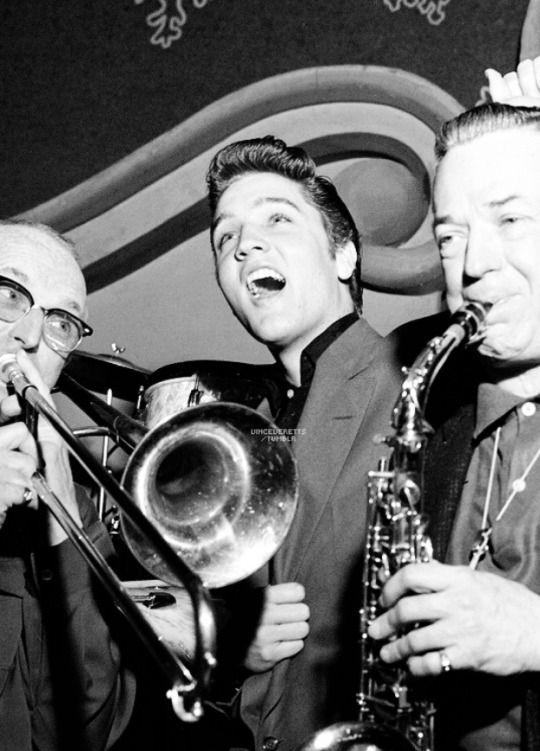
Elvis with Tommy and Jimmy Dorsey at CBS Studio 50, New York, March 17, 1956 [that would be Elvis' 5th appearance on their TV show, out of 6 total.].
------------------------------------------------------------------------------------------------
By December 1955 Elvis had still not made an appearance on national television. His manager Colonel Tom Parker negotiated a deal through Steve Yates with CBS's "Stage Show" for four appearances on the show in January 1956 at $1,250 each and an option for two more at $1,500 each.
On the January 28, 1956, Elvis was broadcast for the nation for the very first time, performing "Shake, Rattle and Roll", "Flip, Flop and Fly" and "I Got a Woman".
youtube
[ABOVE: the January 28th 1956 FULL PERFORMANCE]
On Elvis' first appearance on American television, Bill Randle, one of the most influential disc jockeys of the time, was the man who actually presented Elvis Presley to the nation. He said:
"We'd like at this time to introduce to you a young fellow, who like many performers, Johnnie Ray among them, come up out of nowhere to be overnight very big stars. This young fellow we met for the first time while making a movie short*. We think tonight that he's going to make television history for you. We'd like you to meet him now - Elvis Presley. And here he is!" — Bill Randle, Disc Jockey, the man presenting Elvis Presley to America for the first time. January 28, 1956.
After this, things would never be the same, specially the society. Such a good beginning for a year, that special day in a January month! ♥
------------------------------------------------------------------------------------------------
🎞️THE SHORT-FILM THAT NEVER SAW THE LIGHT OF DAY (for the general public... at least until now...)
The movie short Bill Randle referred to during his introduction to Elvis was "The Pied Piper Of Cleveland - A Day In The Life Of A Famous Disc Jockey" a short film made by Universal pictures about Bill Randle himself. Filmed on October 20th, 1955, at a concert in Brooklyn High School, Cleveland, it featured the stars Bill Haley & The Comets, The Four Lads, Pat Boone, plus the addition of a little-known Elvis Presley.
The original forty-eight-minute film was supposed to be cut down to a twenty-minute "short" for national distribution, but never made it that far. We're in 2024... 69 years went by since this shortcut was produced but the movie remains unreleased.
There is some dispute over whether or not this film actually exists, although it's said it was shown publicly, albeit only once in Cleveland, and excerpts were also aired on a Cleveland television station in 1956. Marshall Lytle, bass player for Bill Haley's Comets, corroborates the existence of the film in his memoir, "Still Rockin' Around the Clock", but he makes the unsubstantiated claim that Colonel Tom Parker, Presley's manager, bought the film and destroyed the existing copies. According to historians, tho, DJ Bill Randle, before his death in 2004, sold the rights to the film to PolyGram (it has been reported that Universal Studios has the negatives of the film in its vaults).
Much uncertainty about this short film, but can you imagine this film being release in Elvis' birthday centenary celebration? We watched, and listened, on Elvis' 89th birthday a few days earlier this year, to them playing during his birthday celebration at Graceland the original "That's All Right" record as it was cut at Sun Records studio in 1954, so who knows? There's always rare things surfacing here and there, so... we better keep our hopes this Bill Randle's 1955 movie, with some new 'baby Elvis' footage, will be release any day now [such as we know there's 'Elvis On Tour' and 'Elvis: That's the Way It Is' never seen before footage coming our way, as confirmed by the "Elvis" 2022 biopic's film director, Baz Luhrmann — finally! We hope it will be released soon].
------------------------------------------------------------------------------------------------
But enough daydreaming... Back to Elvis' 1st television appearances.
After the premiere on America's television on January 28th, 1956, Elvis would do five more appearances on 'The Dorsey Brothers Stage Show" for the next eight weeks. Those would take place on February 4, February 11, February 18, March 17 and March 24th, 1956.
------------------------------------------------------------------------------------------------
February 4th, 1956 | "Baby Let's Play House" and "Tutti Frutti"
youtube
youtube
------------------------------------------------------------------------------------------------
February 11th, 1956 | "Blue Suede Shoes" and "Heartbreak Hotel" *
youtube
youtube
* This is a special arrangement for 'Heartbreak Hotel', so good! Jazzy, dramatic, really rarity. I loved this! ♥
------------------------------------------------------------------------------------------------
February 18th, 1956 | "Tutti Frutti" and "I Was The One"
youtube
youtube
------------------------------------------------------------------------------------------------
March 17th, 1956 | "Blue Suede Shoes" and "Heartbreak Hotel" *
youtube
youtube
* This is the usual arrangement for the "Heartbreak Hotel" song. On February 11th, 1956, Elvis performed this same song onstage of 'The Dorsey Brothers Show' but it sounded something more… dramatic (I guess it matched the lyrics after all, but I love the usual arrangement better yet).
------------------------------------------------------------------------------------------------
And the last one... the 6th appearance on 'Dorsey Brothers Stage Show':
March 24th, 1956 | "Money Honey" and "Heartbreak Hotel" | [FULL PERFORMANCE]
youtube
------------------------------------------------------------------------------------------------
We can see how on those first TV shows Elvis still looks quite shy. Although he moves the usual lot, he doesn't flirt with his audience as much as he would on the upcoming TV appearances (and throughout his life, actually). It's funny how he grew comfortable with being in front of the cameras so fast tho. As his photographer Wiliam Speer said, "I guess you must really like being photographed."
------------------------------------------------------------------------------------------------
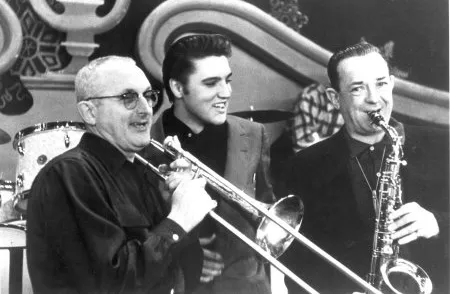
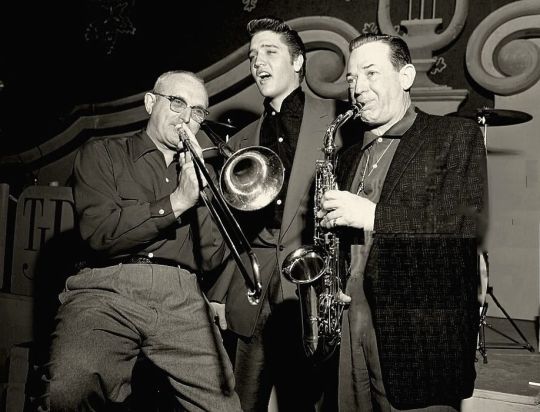
Elvis with Tommy and Jimmy Dorsey at CBS Studio 50 in New York, on March 17, 1956. That would be Elvis' 5th appearance on their TV show. 'The Dorsey Brothers Stage Show' (CBS) was the place Elvis debut in his TV appearances, on January 28th 1956. He would appear on the show for 6 times total, from January to March 1956. ♥
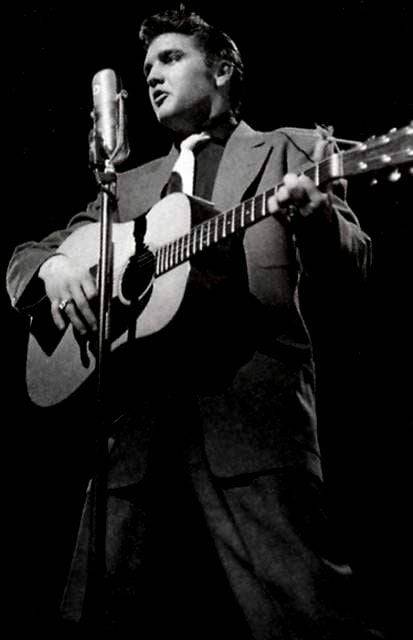
Performing on the 'Dorsey Brothers Stage Show' at the CBS Studio 50, New York City, on March 24th, 1956. His 6th and final appearance on the show.
------------------------------------------------------------------------------------------------
EDIT: THE BLUE MOON BOYS
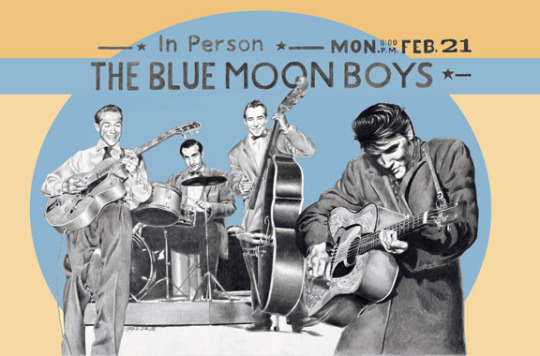
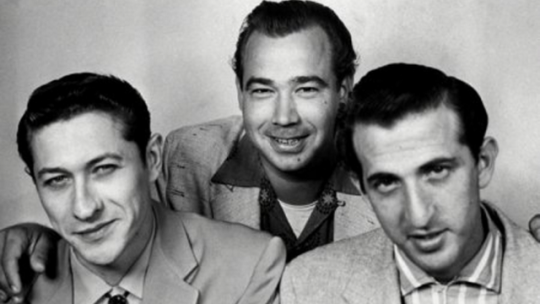
I hate it when I forget to mention such important, trivial, facts — and this shouldn't be footnote info and I feel guilty it is now but I forgot mentioning — The Blue Moon Boys. I love them so much! I watch those footage looking at them as much as I look at Elvis.
Like, I love Bill Black's energy onstage! I love him hollering, vibing to their sound, as loud as Elvis (on occasion). I love how he seem to love chewing gum (Bill is chewing gum in some of those footage), because it makes me look at the Blue Moon Boys and Elvis as a unit, real close friend who look alike, just how it should be. We know although EP for obvious reasons can't chew gum while singing, he loooooved gum and kept this - should I say "habit?" - throughout his life. It's sounding silly what I'm saying, I know, but I think this Elvis habit in fact date from back when he was rocking onstage with Bill, Scotty and DJ Fontana and it makes my heart warm how close and similar they seem to be, as friends, real friends. Bill is actually said to be the one cheering the crowds onstage when they first begun performing, when Elvis was still learning how to be the great leading man he became. When EP was still learning how to act onstage, how to manipulate the audience, creating the mad passionate reactions he learned to create whenever he wanted, Bill was the one heating things up, joking with the audience, cheering, hollering. Bill is amazing! His energy is intoxicating, and we can see it clearly on those first TV appearances performances. ♥
--
I also love how hot Scotty Moore looks! I kinda laughed thinking 'Oh my goodness' ... So this thing about rock and roll bands always having hot vocalists and hot guitar players as a rule, it looks like it all started from the 50s with EP and Scotty! (really, at least the singer and guitar player in most rock bands are hot AF, am I lying? *lol*). I have a thing for Scotty... When he smiles at times on those footage, I'm like: 🤤🥹🥴🫠 And I also love how he's elegant but at the same time menacing looking holding and playing his guitar like the guitar hero he was. Really, if you haven't yet, do yourself a favor and read Scotty's book "THAT'S ALL RIGHT, ELVIS: The Untold Story of Elvis' First Guitarist and Manager, Scotty Moore", by Scotty as told to James Dickerson (1997). Scotty's life story is fascinating and as interesting as Elvis'. ♥
--
And last, but never least, I love how together, calm and concentrated DJ Fontana looks. Ok, unfortunately being the drummer has it's disadvantages. We can't see DJ Fontana as much as we see the other boys onstage, but I listen to the songs until the very last minute and it's amazing how the music always has the closing, the important and dramatic ending, done by DJ's talented hands. I love that guy. ♥
Elvis Presley and The Blue Moon Boys were the best rock and rollers! I love their energy together. As much as I adore 70s Elvis onstage, the TCB Band, the Sweets Inspirations and all, if I only had one performance of Elvis' I could attend, just one to choose, I would go for - undoubtedly - the 50s ones, when those guys, The Blue Moon Boys and Elvis, were playing together.
That's Rock and Roll royalty. ✨👑 ♥
------------------------------------------------------------------------------------------------
There you go. All the videos together so you can watch of them easily. ♥
#elvis for the first time on America television#imagine seeing this baby for the first time out of the blue and then watching him skyrocketing in less than a year...#and then testify as he only grew bigger and bigger and even when he's no longer walking in earth how people still love him#man how I wanted be an old lady just because i would have lived and breathed Elvis Presley 🥹#all i can do is imagine#elvis the king#elvis#elvis presley#the blue moon boys#bill black#scotty moore#DJ fontana#Youtube#elvis fans#elvis fandom#elvis history#50s elvis#tv history#tv shows
83 notes
·
View notes
Text
What I'm Doing With The TS2 Universities: The Best-Laid Plans
So because my darling @uberhood teens are starting to go off to school, I'm starting to remodel the universities! Right now I'm thinking about how to make them distinct from each other-- especially since I overdid it and accidentally added every fucking campus in the game and a few modded ones.
So, I'm making this post so I remember wtf I was planning to do with all of these unis. What architectural styles was I planning to use? What mascots was I planning to give them?
Sim State University
Elevator Pitch: Rub elbows with SimNation's best and brightest-- or get invited to their epic ragers-- at SSU.
Inspiration: The College of William and Mary. An old, red brick campus that's split into the Old Campus and New Campus? That's Sim State U if we ever saw it.
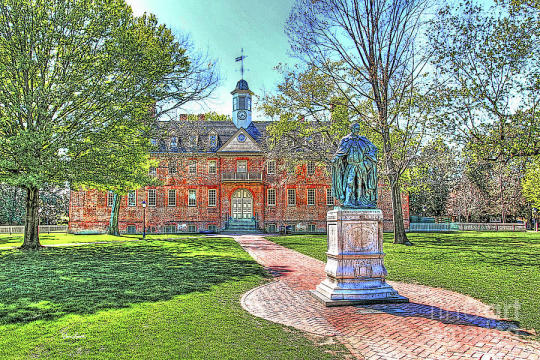
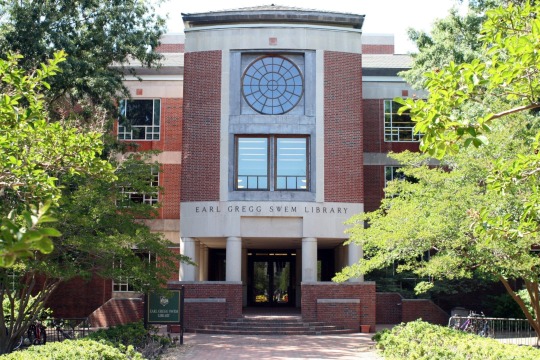
Majors: International Relations (modded), Political Science, History, Economics Mascot: The Fightin' Llamas. Rival School: Land Grant University.
La Fiesta Tech:
Elevator Pitch: The truth is out here! Unlock the secrets of the universe at La Fiesta Tech.
Inspiration: New Mexico State's more modern architecture
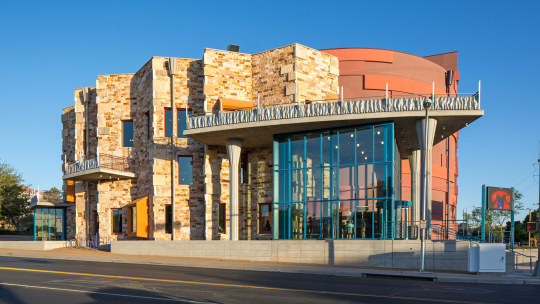

Majors: The "Four Ps"-- Paranormal (modded), Physics, Psychology, Philosophy Mascot: The Antisocial Bunnies Rival School: Cactus Canyon University
Academie Le Tour:
Elevator Pitch: "Alta cultura, altior drama." If you want to study the liberal arts, there's nowhere better than Academie Le Tour.
Inspiration: Was it ever going to be anything other than Oxbridge? It was never going to be anything other than Oxbridge.
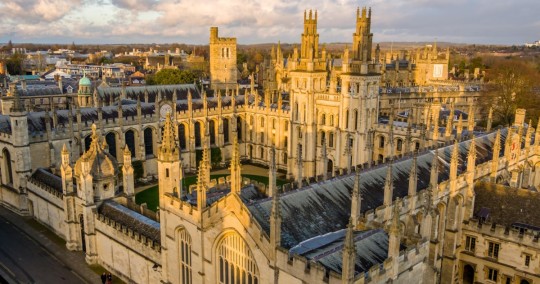
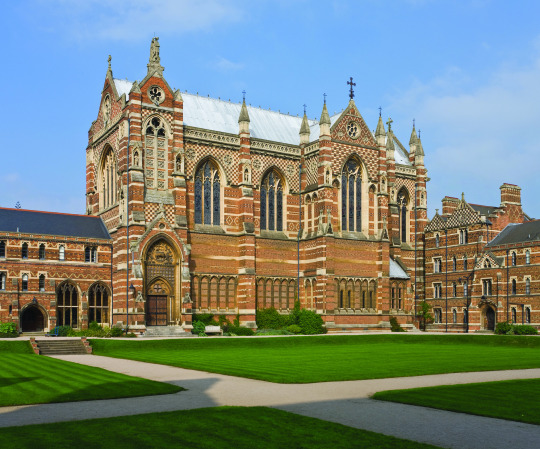
Majors: Languages (modded), Art, Literature, Drama
Mascot: The Magic Dragons. (TS4 Oxbury Dragon)
Rival School: Caelestis University
Land Grant University:
Elevator Pitch: Higher education is a new concept in the area. We'll see how it works out. (~@penig)
Inspiration: Texas A&M. I don't expect to have to remodel too many of the buildings, because this isn't a Maxis school-- but if I do, I'm gonna use The Agricultural School Par Excellence as inspo.
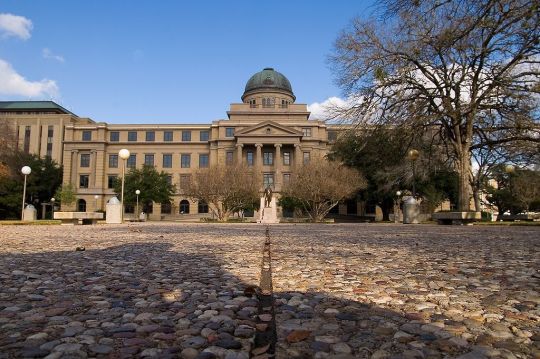
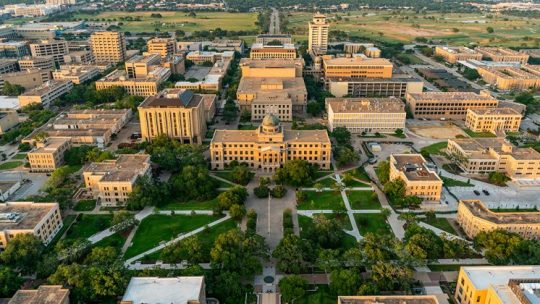
Majors: Agricultural Business, Animal Sciences, Plant Sciences (modded), Biology
Mascot: The Ragin' Bulls (AKA: Cow)
Rival School: Sim State University
Cactus Canyon University:
Elevator Pitch: "The cosiest college in SimNation." Come for the campus life, stay because we've got the best pre-med program in the area.
Inspiration: Honestly? CCU has its own architectural style and I'm Here For It; thanks @aondaneedles!

Majors: Sport Studies, Nursing, Dentistry (modded), Mathematics
Mascot: The Pluckin' Chickens
Rival School: La Fiesta Tech.
Caelestis University:
Elevator Pitch: "Study the quirkier side of life and find your people."
Inspiration: OCAD University, Toronto. A mix of traditional turn-of-the-century architecture and the most Gonzo Pomo shit you ever have seen.
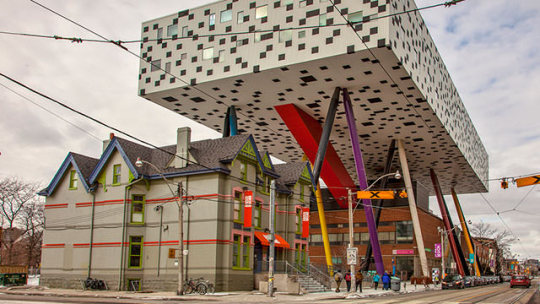
Majors: Galactic Ambassador (modded), Crisis Management (modded), Fashion (modded), Art
Mascot: The Clackin' Lobster (from TS4 Britechester)
Rival School: Academie Le Tour
Quaddington University:
Elevator Pitch: "Braiiiiiiiiiiiiiiiins...."
Inspiration: The entirety of Abandonedamerica.us, but especially the Warner Swasey Observatory in Cleveland (and, by extension, Case Western Reserve University).

Majors: Dead Languages, Law (modded), Drama, Philosophy
Mascot: N/A. Might un-default the Brahmin mascot suit from @davinaojeda's Fallout set-- I think that would be funny.
Rival School: N/A. Quaddington U just opened its doors to the public again, and hasn't really had time to reestablish rivalries.
#ts2#sims 2#ts2 university#uberhood#sim state university#la fiesta tech#academie le tour#land grant university#cactus canyon university#caelestis university#quaddington university
30 notes
·
View notes
Text
Wait, wait, there's one last Letters from Watson for A Study in Scarlet, and it has the ANSWER to my question from the last one.
Having left the house, I proceeded to do what Gregson had neglected. I telegraphed to the head of the police at Cleveland, limiting my enquiry to the circumstances connected with the marriage of Enoch Drebber. The answer was conclusive. It told me that Drebber had already applied for the protection of the law against an old rival in love, named Jefferson Hope, and that this same Hope was at present in Europe
So Drebber not only asked for police protection, but the police were motivated to trace Hope to Europe. Drebber must surely have been very rich to get this level of service for his tax dollars.
The rest of Holmes' explanation is such an interesting reveal of how important contextual knowledge is. It's obvious enough when he's first investigating that the carriage wheel tracks mean something, but as a twenty-first century digital gal, I could never have filled in the blanks on the difference in carriage wheel gauge.
My 13 days of Duolingo Latin (it's a very short course) gave me a working knowledge of drunken parrots in the marketplace, but nothing sufficient to the final quote. (I cannot decide if I envy or sympathize with the generations of English public school boys who had to learn Latin and Greek. The skill seems handy -- and characters certainly quote at one another madly in novels -- but it's never so handy in real life that I do anything about it. Everything gets easier by the Golden Age of Mysteries, when the aphorisms are as likely to be in French.)
People hiss at me, but I applaud myself At home, I contemplate the money in the box.
20 notes
·
View notes
Text
I was born and raised in Gary, Indiana, so this story resonates deeply with me. Way too many of my high school friends died young from heart and lung diseases easily traceable to the crud in the air we all breathed for years.
Excerpt from this story from the Chicago Tribune:
The “Dirty Steel, Dangerous Air” report details the national and local health and economic costs of steel industry pollution. Industrious Labs released the report on Monday.
Industrious Labs is an environmental organization focused on cleaning up industries through network and capacity building, research and analysis, and data-driven campaigns, according to its website.
The 44-page report found that coal-based steelmaking contributes to an estimated $13.2 billion in health costs, 892 premature deaths and almost 100,000 lost school and work days annually, according to a news release from the organization.
“Steel communities have been sounding the alarm on harmful air pollution for years, and this report quantifies just how devastating and far-reaching the consequences are,” Hilary Lewis, steel director at Industrious Labs, said in the news release. “The EPA has consistently failed to safeguard the health of these communities from the dangers of coal-based steelmaking. It’s time for stronger regulations that recognize the opportunity of cleaner steelmaking technologies and tougher enforcement of penalties on polluters to truly protect public health.”
The report focuses on 17 facilities nationwide, including four plants in Northwest Indiana, each of which are owned by U.S. Steel or Cleveland-Cliffs.
In addition to steelmaking, the report looks at the harmful effects of coke, a processed form of coal used in steelmaking.
The steel industry accounts for more than 90% of the market demand for coke, according to the report, which called coke a “very dirty fossil fuel.”
The product is made by mixing coal with oil or water and heating it at 2,000 degrees for many hours. Coke requires dozens of large ovens to be made as well, according to the report.
Industrious Labs’ report also found that most residents in Gary are in the top 10% of U.S. residents most at risk for developing asthma and at risk of low life expectancy.
The city is home to U.S. Steel’s Gary Works facility, which could potentially receive $300 million for its blast furnace if a deal between the company and Nippon Steel is approved.
The $300 million investment will allow for higher steel production and reduced emissions, Gary Mayor Eddie Melton said in a statement. The furnace should have its life extended by up to 20 years.
Some residents, including those who are members of Gary Advocates for Responsible Development, have concerns about the investment.
Carolyn McCrady, member of GARD, said the only way for the steel industry to grow in “a healthy way” is to get rid of blast furnaces. McCrady believes in the use of direct reduction furnaces, which she calls more environmentally and economically friendly.
Direct reduction furnaces could reduce carbon dioxide emissions by half and produce about 20% of steel nationwide, McCrady said.
5 notes
·
View notes
Text
“An Absolute Massacre” – The New Orleans Slaughter of July 30, 1866
Reconstruction Era National Historical Park

Political Cartoonist Thomas Nast drew this political cartoon, "The Massacre at New Orleans," criticizing President Andrew Johnson for his role in permitting the violence to unfold in New Orleans on July 30, 166
The Confederate military and government collapsed in the Spring and Summer of 1865, effectively ending the Civil War with the United States preserved and slavery destroyed. But the violence was far from over. White resistance to Black citizenship during Reconstruction often turned violent – as it did in New Orleans on July 30, 1866. During the war, President Abraham Lincoln had hoped that Louisiana, with a strong US military presence in Louisiana would serve as the model for readmitting states back to the United States. In 1864, the state ratified a new constitution that abolished slavery, but did not grant Black Louisianans the right to vote – something that President Lincoln began to consider as the war ended the next year.
In his last speech, delivered on April 11, 1865, Lincoln openly expressed his desire to enfranchise select freed people and emphasized that “…voters in the heretofore slave-state of Louisiana have sworn allegiance to the Union… held elections, organized a State government, adopted a free-state constitution, giving the benefit of public schools equally to black and white, and empowering the Legislature to confer the elective franchise upon the colored man.
Their Legislature has already voted to ratify the constitutional (Thirteenth) amendment recently passed by Congress, abolishing slavery throughout the nation.”1 In the crowd was John Wilkes Booth. Incensed at the thought of Black citizenship and voting, Booth assassinated President Lincoln a few days later. The violence did not stop at Ford’s Theatre.
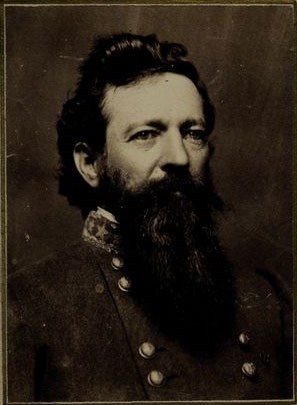
Harry T. Hays had served as a General in the Confederate Army. But in the Summer of 1866, he was the Sheriff of New Orleans, and deputized a posse of ex-Confederates to confront a citizen's convention in the city.
Gilder Lehrman Institute

This image from Harpers Weekly depicts Confederate veterans opening fire on the crowd in New Orleans. The placement of the US flag in the drawing served as a reminder to readers that some former Confederates had not yet accepted the outcome of the war.
Library of Congress
In a matter of approximately two hours, 34 African American supporters were killed, while the wounded numbered 119. Three of the delegates who had assembled in the Mechanics Institute were killed, while 17 were wounded, and approximately 200 others arrested. When the streets around the Mechanics Institute fell quiet, General Baird ordered martial law, which remained in effect into early August. On August 1, the Cleveland Daily Leader published sentiments that were shared by many other papers across the North: “Remember that this work was done by the constituted authorities of the city of New Orleans, rebels in record and in heart, but placed in power over loyal men by the policy of a renegade President. Remember that these scenes are but a prelude of what is to be… if Mr. Johnson’s policy shall be carried out.”5 Paired with news of the tragedy that occurred in Memphis months before, the New Orleans massacre contributed to major changes in Reconstruction policy. The 1866 elections saw to it that a Radical Republican majority ruled in both the House of Representatives and Senate, and ultimately contributed to the passing of the 14th and 15th Amendments. It could even be said that the violence which transpired on July 30, 1866, in a twist of irony, gave rise to several policies that would be enacted in following years, including Federal military presence in the South, temporary disenfranchisement of former Confederates, and for a population of more than four million freed people - the right to vote. 1 Lincoln, Abraham, and Scott Yenor. “Document 5: Last Public Address.” Reconstruction: Core Documents, Ashbrook Center, Ashland University, 2018, pp. 13–17. 2 O'Donovan, Susan, and Beverly Bond. “‘A History They Can Use’: The Memphis Massacre and Reconstruction's Public History Terrain.” The Journal of the Civil War Era, 10 Jan. 2018, www.journalofthecivilwarera.org/2016/08/history-can-use-memphis-massacre-reconstructions-public-history-terrain/. 3Reynolds, Donald E. “The New Orleans Riot of 1866, Reconsidered.” Louisiana History: The Journal of the Louisiana Historical Association, vol. 5, no. 1, 1964, pp. 5–27. JSTOR, www.jstor.org/stable/4230742. Accessed 30 July 2020. 4 The New-Orleans Riot. Its Official History. New York Tribune, 1866. 5 The Louisiana Convention. Cleveland Daily Leader, 1 August, 1866, p. 1. by Park Ranger Rich Condon, Reconstruction Era National Historical Park
#“An Absolute Massacre” – The New Orleans Slaughter of July 30#1866#Reconstruction Era National Historical Park#New Orleans Massacre#louisiana#Black Voting Rights#confederates#civil war.#white supremacy#Black Freedmen
7 notes
·
View notes
Text
As we near the end of pride month, I would like to celebrate a number of LGBTQ+ figures that may be unknown to some.
Alan Turing (1912 - 1954)
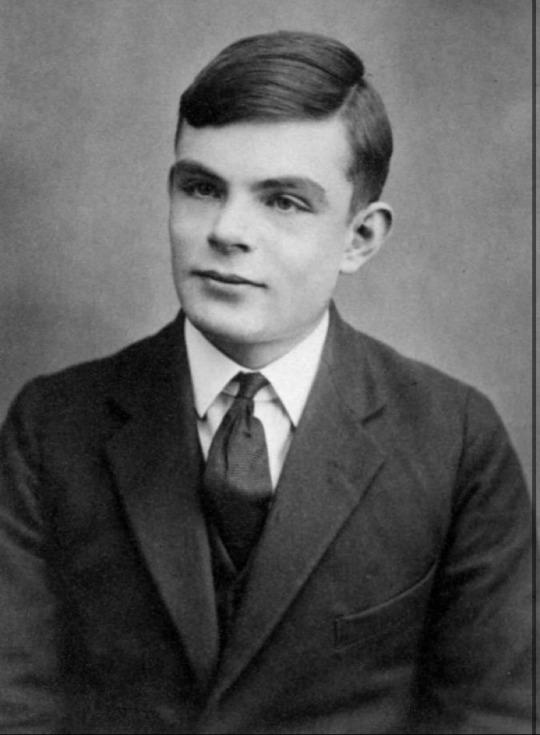
Alan Turing was British mathematician, cryptologist, and computer scientist who is credited as the founder of modern computer science and artificial intelligence. During World War II, he worked for Britain’s Government Code and Cypher School at Bletchley Park, leading the effort to decrypt German naval intelligence. Turing created a number of methods and devices that helped crack the German Enigma Code and allowed the allies to read German intelligence and allow allied ships to avoid U-Boat ‘Wolf-packs’. Turing’s work was pivotal in helping the allied victory in the war. Sadly, Turing was arrested in 1952 for homosexual acts and convicted of ‘gross indecency’. He accepted chemical castration as an alternative to prison. In 1954, was found dead from suicide by cyanide poisoning. It’s believed that Turing’s work helped shortened the war by several years.
Harvey Milk (1930 - 1978)

Harvey Milk was a politician and the first openly gay man to serve in public office in the United States. Milk moved to San Francisco in 1972 and took up residence in the Castro District, a neighborhood that was heavily populated by lesbians and gay men, and opened a camera store called Castro Camera. Milk became involved in politics because of civic issues and policies that drew his ire. Homosexuality was still heavily persecuted in the city at the time. In 1973, he announced his declared his candidacy for city supervisor. However, he faced a negative reception from the established gay political scene and lost the election. He lost his second election two years later. By this point, Milk had become a leading figure in the gay community, known as the “Mayor of Castro Street”, and had allies that included Mayor George Moscone, Assembly Speaker Willie Brown, and future Senator Diane Feinstein. Finally, in 1978, Milk was elected to the San Francisco Board of Supervisors, inaugurated January 8. During his tenure he was involved in a number of issues including childcare, housing, and police reform. Sadly, he only served eleven months in office before he, along with George Moscone, was assassinated by former supervisor Dan White, who was against many of Milks policies. Today, Harvey Milk is considered an icon of San Francisco and a martyr of the LGBTQ movement.
Rose Cleveland (1846 - 1918)
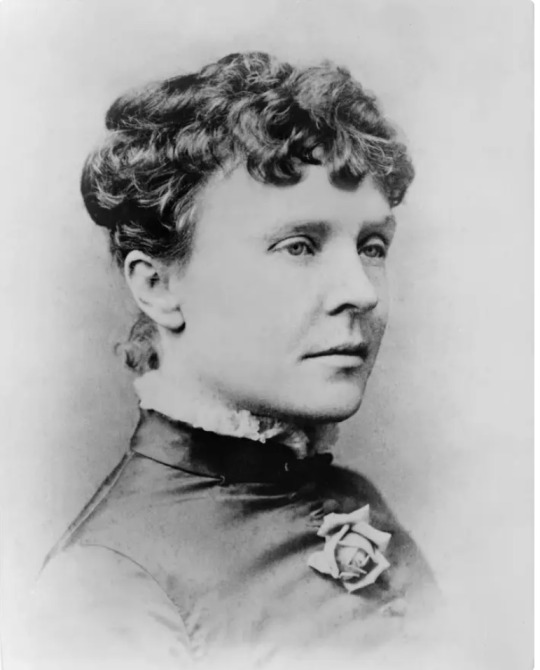
Rose Cleveland was the sister of U.S. President Grover Cleveland and, as such, acted as First Lady of the United States from his inauguration until he married Frances Folsom in 1886. After leaving the White House she became a teacher, writer, and lecturer in Indiana. At age 44 she started a romantic relationship with wealthy widow Evangeline Marrs Simpson. They exchanged numerous letters, some with explicitly erotic imagery. The relationship cooled after six years after Simpson married Episcopal preacher Bishop Henry Whipple, despite Cleveland’s protests. After Whipple died in 1901, their relationship resumed. Cleveland and Evangeline moved to Bagni di Lucca, Italy in 1910, where they cared for Evangeline’s ill brother and settled there after his death. They lived there together until Cleveland died during the 1918 Influenza Pandemic. After her death, Evangeline wrote “the light has gone out for me…the loss of this noble and great soul is a blow that I shall not recover from”. Evangeline died in 1930 and is buried in the cemetery in Italy next to Rose. Many of their letters remain an important part of LGBTQ history.
Andy Warhol (1928 - 1987)

Andy Warhol was an American artist, director, and producer who was a leading figure in the pop art movement of the 1950’s to 1970’s. This movement focused on combining fine art with elements of popular culture, hence the name pop art. Warhol’s paintings focused on mass produced consumer goods and celebrity portraits. Warhol’s most famous pieces include Campbell’s Soup Cans (1962), Green Coca-Cola Bottles (1962), Marilyn Diptych (1962), and Mao Tse-Tung (1972). He also directed and produced experimental films including Empire (1964) and Chelsea Girls (1966). His New York City gallery, The Factory, was a popular gathering place for artists, musicians, actors, socialites, and celebrities. In 1966, he became the manager of rock band The Velvet Underground, which became the house band of The Factory. In 1969, he created Interview magazine, which features interviews with celebrities, artists, musicians, and other creatives. Warhol lived openly as a gay man before the gay liberation movement and had a series of male partners. He said his sexuality was a major influence of his work. Warhol died on February 22, 1987 due to complications from a gallbladder surgery. Andy Warhol is regarded as one of America’s most famous visual artists.
Gladys Bentley (1907 - 1960)
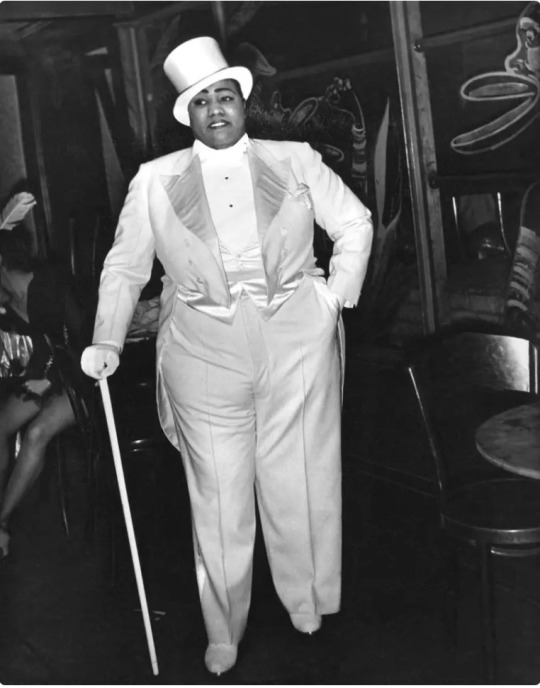
Gladys Bentley was an American blues singer, pianist, and entertainer during the Harlem Renaissance of the 1920’s and 1930’s. Her career took off after performing at Harry Hansberry’s Clam House, a well known gay speakeasy in New York City. She gained popularity as a black, lesbian, cross dressing performer. She performed in men’s clothes and was backed up by a chorus of drag queens. She sang with a deep, growling voice, and took popular songs and added her own raunchy lyrics while flirting with women in the audience. Despite being openly lesbian in the beginning of her career, she later started wearing dresses and married during the more conservative 1950’s in order to adapt to the mindset of the time period. Bentley died of pneumonia in 1960 and is remembered as an icon of both the LGBTQ and Black communities.
Willem Arondeus (1894 - 1943)

Willem Arondeus was an openly gay Dutch artist and writer who fought for the Dutch resistance against Nazi occupation during World War II. Prior to the war, he wished to work as an artist, but he found very little popularity, so he turned to writing instead. After Germany occupied The Netherlands, Arondeus joined the Resistance Movement, publishing underground periodicals and forging documents. His most famous endeavor, was his involvement in the bombing of the Amsterdam Civil Registry in 1943. The Civil Registry was established following the German invasion and occupation of the Netherlands in 1940 and was used to keep records of all residents of the country and identified those who were Jewish, resistance members, and those who could be called up for forced labor. On March 27, resistance members, including Arondeus, entered the building by disguising themselves as police officers and sedating the guards. They then piled all the documents on the floor and set of explosives. They fire department delayed putting out the fire and then doused the whole building with water. 800,000 ID cards were destroyed in total. Unfortunately, someone betrayed Arondeus and he was subsequently arrested, tried, and sentenced to death. Before his execution, his last words were “tell people that homosexuals are not cowards”.
Gilbert Baker (1951 - 2017)
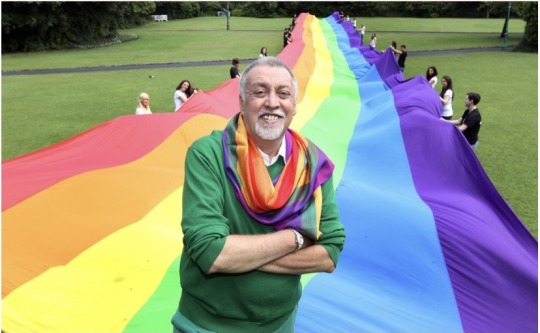
Gilbert Baker was an American artist and designer who is the original creator of the LGBTQ Rainbow Pride flag. He joined the anti-war movement in the 1970’s where he met, and became friends with, Harvey Milk. Milk commissioned Baker to create a flag that could represent gay pride. Using the American flag as inspiration, Baker hand sew the original flag, which had eight colored stripes (two more than the modern version). Each color represents a different aspect important to the gay community: (from hot pink to violet) sex, life, healing, sunlight, nature, magic, serenity, and spirit. The flag was first flown in San Francisco on June 25, 1978, for gay pride day. Baker died in 2017, and is regarded as a major figure in the pride movement. Today there are many different variations of the Pride flag, with each one representing a different group from the gay community
Larry Kramer (1935 - 2020)

Larry Kramer was an American playwright, author, film producer, and gay rights activist, who worked to bring awareness to the AIDS crisis in the 1980’s. He began his career writing scripts for Columbia pictures, winning an Academy Award for the 1969 film Women in Love. After witnessing the disease later known as AIDS spread among his friends, Kramer became involved in gay activism. In 1982, Kramer co-founded Gay Men’s Health Crisis, now known as GMHC, which provides social services for those infected with AIDS, along with testing, legal assistance, and mental health support. It’s currently the largest AIDS assistance organization in the world After, growing frustrated with the government paralysis and apathy towards gay men, he wanted to engage in further action, so in 1987, he helped found the AIDS Coalition to Unleash Power (ACT UP). ACT UP is a direct action protest organization that works to change legislation and public policy to end the AIDS crisis. ACT UP soon had chapters in cities all over the United States. The movement then spread internationally, with separate movements being established in other countries including the United Kingdom, Canada, France, India, and Germany. In 1992, Kramer wrote the play ‘The Destiny of Me’, which follows a character from his 1985 play ‘The Normal Heart’ seeking experimental treatment for AIDS. The play was a finalist for the Pulitzer Prize. The Normal Heart debuted on Broadway in 2011, and was adapted into an HBO movie in 2014. Kramer died of pneumonia on May 27, 2020.
Bessie Smith (1894 - 1937)

Bessie Smith was an American blues singer, nicknamed the ‘Empress of Blues’. She was the most popular female blues singer of the 1930’s. Smith stated her career busking in the streets to help her family financially. In 1912, she auditioned for a music troupe that included blues legend Ma Rainey. She was originally hired as a dancer. Smith began her solo career at the 81 Theater in Atlanta, Georgia. She signed with Columbia Records in 1923. She made 160 recordings for Columbia, accompanied by some of the most famous musicians of the day including Louis Armstrong, Coleman Hawkins, Fletcher Henderson, and Sidney Bechet. She became the highest paid black entertainer of the day. Throughout her career, smith was apologetically herself, having affairs with both men and women. Some speculate her bisexuality was hinted at in the lyrics of her songs, including ‘boy in the boat’: “when you see two women walking hand in hand/Just look ‘em over and try to understand/They’ll go to those parties/Having the lights down low/Only those parties where women can go”. Sadly, her career was cut short in 1937, when she died at the age of 43 due to injuries sustained in a car accident enroute to Chattanooga, Tennessee. Her funeral was attended by more then 5,000 people. In 1989, she was inducted into the Rock and Roll Hall of Fame, with an entry saying her reign was “definitive, unprecedented, and glorious”.
James Baldwin (1924 - 1987)

James Baldwin was an American writer who gained critical acclaim across multiple forms, including essays, novels, plays, and poems. In 1953, he published his first book ‘Go Tell it on the Mountain’, a semi-autobiographical novel which tells the story of a young African American man who grew up in Harlem, New York City, and his relationship with his family and the Pentecostal Church. In 1998, Modern Library ranked the book 39th on its list of 100 best English language novels of the 20th century. In 2005, Time Magazine included the book in its list of the 100 Best Novels from 1923 (when Time was first published) to 2005. In 1956, Baldwin wrote ‘Giovanni’s Room’ whose main character was a gay American man living in Paris, France, who began an affair with an Italian bartender named Giovanni, whom he met at a Gay bar. Gay and Bisexual men are also frequently featured in his other works. His unfinished manuscript Remember This House was expanded and adapted in the 2016 Oscar nominated documentary I Am Not Your Negro, which won the BAFTA Award for Best Documentary. His 1974 novel ‘If Beale Street Could Talk’ was adapted into a movie in 2018, which won Best Supporting Actress for Regina King at the 91st Academy Awards, where the film was also nominated for Best Adapted Screenplay and Best Original Score. King also received Best Supporting Actress at the 76th Golden Globe Awards and 24th Critics Choice Awards. Both the National Board of Review and the American Film Institute included it in their top 10 films of 2018. Today, James Baldwin is considered one of the most famous LGBTQ writers in American history.
#history#queer pride#pride month#queer stuff#queer history#lgbtq#bisexual#homoseuxality#gay pride#pride 2023
46 notes
·
View notes
Text
Venture predation

Tomorrow (May 20), I’ll be at the GAITHERSBURG Book Festival with my novel Red Team Blues; then on Monday (May 22), I’m keynoting Public Knowledge’s Emerging Tech conference in DC.
On Tuesday (May 23), I’ll be in TORONTO for a book launch that’s part of WEPFest, a benefit for the West End Phoenix, onstage with Dave Bidini (The Rheostatics), Ron Diebert (Citizen Lab) and the whistleblower Dr Nancy Olivieri.

They said it couldn’t happen. After decades of antitrust enforcement against Predatory Pricing — selling goods below cost to kill existing competitors and prevent new ones from arising — the Chicago School of neoliberal economists “proved” that predatory pricing didn’t exist and that the courts could stand down and stop busting companies for it.
Predatory pricing — the economists explained — may be illegal, but it was also imaginary. A mirage. No one would do predatory pricing, because it was “irrational.” And even if there was someone irrational enough to try it, they would fail. Stand down, judges of America — predatory pricing is solved.
Chicago School economists — whose job (to quote David Roth) is to find new ways to say “actually, your boss is right” — held enormous sway of the federal judiciary. The billionaire-backed Manne Seminars offered free “continuing education” junkets to judges — all-expense-paid luxury vacations salted with lengthy your-boss-is-right econ seminars. 40% of the US federal judiciary got their heads filled up at a Manne Seminar.
For monopolists and other predators, the Manne Seminar was an excellent return on investment. After attending a Manne Seminar, the average judge’s legal decisions tipped decidedly in favor of monopoly, operating on the Chicago bedrock assumption that monopolies are “efficient,” and, where we see them in nature, we should celebrate them as the visible manifestation of the entrepreneurial genius of some Ayn Rand hero in a corporate boardroom:
https://pluralistic.net/2021/08/13/post-bork-era/#manne-down
A little knowledge is a dangerous thing. Even as post-Chicago economists showed that predatory pricing was both possible and rampant, a “rational” and effective strategy for cornering markets, suppressing competition, crushing innovation and gouging on price, judges continued to craft tortuous, unpassable tests that any predatory pricing case would have to satisfy to proceed. Economics moved on, but predatory pricing cases continued to fail the trial-by-ordeal constructed by Chicago-pilled judges.
Which is a shame, because there are at least three ways that predatory pricing can be effective:
Cost Signaling Predation: A predator tricks competitors into thinking they’ve found a new way to cut their costs, which allows them to drop prices. Competitors, fooled by the ruse, exit the market, not realizing that the predator is merely subsidizing their products’ costs to trick them.
Financial Market Predation: A predator tricks the competitors’ creditors into thinking the predator has a new way to cut costs. The creditors refuse to loan the prey companies the money needed to survive the price war, and the prey drops out of the war.
Reputation Effect Predation: A predator subsidizes prices in one region or one line of goods in order to trick prey into thinking that they’ll do the same elsewhere: “Don’t try to compete with us in Cleveland, or we’ll drop prices like we did in Tampa.”
These models of successful predation are decades old, and have broad acceptance within economics — outside of Chicago-style ideologues — but they’ve yet to make much of a dent in minds of the judges who hear Predatory Pricing cases.
While judges continue to hit the snooze-bar on any awakening to this phenomenon, a new kind of predator has emerged, using a new kind of predation: the Venture Predator, a predatory company backed by venture capital funds, who make lots of high-risk bets they must cash out in ten years or less, ideally for a 100x+ return.
Writing in the Journal of Corporation Law Matthew Wansley and Samuel Weinstein — both of the Cardozo School of Law at Yeshiva University — lay out a theory of Venture Predation in clear, irrefutable language, using it to explain the recent bubble we sometimes call the Millennial Lifestyle Subsidy:
https://papers.ssrn.com/sol3/papers.cfm?abstract_id=4437360
What’s a Venture Predator? It’s “a startup that uses venture finance to price below its costs, chase its rivals out of the market, and grab market share.” The predator sets millions or billions of dollars on fire chasing “rapid, exponential growth” all in order to “create the impression that recoupment is possible” among future investors, such as blue-chip companies that might buy them out, or sucker retail investors who buy in at the IPO, anticipating years of monopoly pricing.
In other words, the Venture Predator constructs a pile of shit so large and impressive that investors are convinced that there must be a pony under there somewhere.
There’s another name for this kind of arrangement: a bezzle, which Galbraith described as “the magic interval when a confidence trickster knows he has the money he has appropriated but the victim does not yet understand that he has lost it.”
Millennial Lifestyle Subsidy companies are bezzles. Uber, annihilated tens of billions of dollars on its bezzle, destroying the taxi industry and laying waste to public transit investment, demolishing labor protections and convincing people that impossible self-driving robo-taxis were around the coner:
https://pluralistic.net/2021/02/16/ring-ring-lapd-calling/#uber-unter
But while Uber the company lost billions of dollars, Uber’s early investors and executives made out like bandits (or predators, I suppose). The founders were able to flog their shares on the secondary market long before the IPO. Same for the early investors, like Benchmark capital.
Since the company’s IPO, its finances have steadily worsened, and the company has resorted to increasingly sweaty balance-sheet manipulation tactics and PR offensives to make it seem like a viable business:
https://pluralistic.net/2022/08/05/a-lousy-taxi/#a-giant-asterisk
But Uber can’t ever recoup the billions it spent convincing the market that there was a pony beneath its pile of shit. The app Uber uses to connect riders with the employees it misclassifies as contractors isn’t hard to clone, and it’s not hard for drivers or riders to switch from one app to another:
https://locusmag.com/2019/01/cory-doctorow-disruption-for-thee-but-not-for-me/
Nor can Uber prevent its rivals from taking advantage of the hundreds of millions of dollars it spent on “regulatory entrepreneurship” — changing the laws to make it easier to misclassify workers and operate unlicensed taxi services.
It’s not clear whether Uber ever believed in robo-taxis, or whether they were just part of the bezzle. In any event, Uber’s no longer in the robotaxi races: after blowing $2.5B on self-driving cars, Uber produced a vehicle whose mean-distance-between-fatal-crashes was 0.5 miles. Uber had to pay another company $400M to take its self-driving unit off its hands:
https://pluralistic.net/2022/10/09/herbies-revenge/#100-billion-here-100-billion-there-pretty-soon-youre-talking-real-money
Uber’s prices rose 92% between 2018–21, while its driver compensation has plunged. The company is finding it increasingly difficult to passengers into cars, and drivers onto the road. They have invented algorithmic wage disrimination, an exciting new field of labor-law violations, in order to trick drivers into thinking there’s a pony under all that shit:
https://pluralistic.net/2023/04/12/algorithmic-wage-discrimination/#fishers-of-men
To Uber’s credit, they have been a wildly innovative company, inventing many new ways to make the pile of shit bigger and the pony more plausible. Back when Uber and Lyft were locked in head-to-head competition, Uber employees created huge pools of fake Lyft rider accounts, using them to set up and tear down rides in order to discover what Lyft was charging for rides in order to underprice them. Uber also covertly operated the microphones in its drivers’ phones to listen for the chimes the Lyft app made: drivers who had both Lyft and Uber installed on their devices were targeted for (strictly temporary) bonuses.
Uber won’t ever recoup, but that’s OK. The investors and execs made vast fortunes. Now, normally, you’d expect company founders and other managers with large piles of stocks in a VC-backed company to be committed to the business’s success, at least in the medium term, because their shares can’t be liquidated until well after the company goes public.
But the burgeoning “secondary market” for managers’ shares has turned investors and managers into co-conspirators in the Venture Predation bezzle: “half of Series A and B deals now have some secondary component for founders.” That means that founders can cash out before the bezzle ends.
The trick with any bezzle is to skip town while the mark is still energetically digging through the shit, before the pony is revealed for an illusion. That’s where crypto comes in: during the cryptocurrency bubble, VCs cashed out of their investments early through Initial Coin Offerings and other forms of securities fraud. The massive returns this generated were well worth the millions they sprinkled on Superbowl ads and bribes for Matt Damon.
But woe betide the VC who mistimes their exit. As Wework showed, it’s entirely possible for VCs to be left holding the bag if they get the timing wrong. Wework blew $12b on predatory pricing — promising tenants at rivals’ businesses moving bonuses or even a year’s free rent, all to make the pile of shit look larger and thus more apt to contain a pony. The company opened its co-working spaces as close as possible to existing shops, oversaturating hot markets and showing “growth” by poaching customers through deep subsidies, then pretending that those customers would stay when the subsidies evaporated. But Wework’s “product” was temporary hot-desks, occupied by people who could (and did) move at the drop of a hat.
To its competitors, its competitors’ creditors, and credulous investors, it appeared that Wework had developed some kind of “efficiency advantage” — a secret sauce that let it sell a product at a price that was far below its rivals’ costs. But once Wework filed for its IPO, its S-1 — the form that discloses the company’s finances — revealed the truth. Wework’s only “advantage” was the bafflegab of its cult-like leader and the torrent of cash supplied by its VCs.
Wework’s IPO was a disaster. After canceling a real IPO, the company eventually went public through a scammy SPAC, saw its shares immediately tank, and continue to fall, as its balance-sheet is still blood-red with losses.
Another Venture Predator is Bird, the company that flooded American cities with cheap, flimsy Chinese scooters, choking curbs and sidewalks. 25% of the gross revenues from each scooter ride had to be written off as depreciation on the scooter. As a Bird spokesperson told the LA Times: “There are very few unique companies for which you can build global scale really quickly and build a dominant market position before other people do, and for those rarefied companies scaling quickly matters more than short-term profits.”
Bird was another company that could never recoup, whose executives and investors could only cash out if they could maintain the faint hope of the pony underneath its pile of shitty scooters. It drove the company to some genuinely surreal lengths. For example, in 2018, I reported on the existence of a kit that let you buy an impounded Bird scooter for pennies and retrofit it to run without an app, so you could take it anywhere:
https://boingboing.net/2018/12/08/flipping-a-bird.html
Shortly thereafter, I got a legal threat from Linda Kwak, Bird’s Senior Corporate Counsel, claiming that publishing a link to a website that sells you a product you install by unscrewing one board and inserting another was a violation of Section 1201 of the DMCA, which was an astonishingly stupid claim:
https://www.eff.org/document/bird-rides-takedown-boing-boing-dec-20-2018
It was also an astonishingly stupid claim to make to me, a career activist with 20 years experience fighting DMCA1201, a decades-old professional affiliation with EFF, and a giant megaphone:
https://boingboing.net/2019/01/11/flipping-the-bird.html
But Bird was palpably desperate to keep its bezzle going, and Kwak — an employment lawyer with undeniable deficits in her understanding of copyright and cyber-law — was their champion
Fascinatingly, one thing Bird didn’t worry about was competition from Uber and Lyft, who piled into the e-scooter market. Bird circulated a (leaked) pitch-deck reassuring investors that Uber/Lyft weren’t gunning for them, because they ““won’t subsidize prices” as they prepared for their IPOs, which involved disclosing their finances to their investors.
Bird’s investors either lost money or made small-dollar returns, but they were outfoxed by Bird founder Travis VanderZanden, a superpredator who cashed out $44m in shares just as the VCs were piling in.
Venture Predation is another stinging rebuttal to the Chicago School’s blithe dismissal of Predatory Pricing as an illusion. Private firms — of the sort that VCs back — whose boards are made up of founders and VCs who stand to benefit from the pile-of-shit gambit are perfectly capable of spending huge fortunes to make Predatory Pricing work. VCs make a practice of repeatedly co-investing in businesses together, which fosters the kind of trust that allows for these gambits to be played again and again.
For later stage, pony-thirsty investors who get stuck holding the bag, the lure of monopoly profits is both powerful and plausible — after 40 years of antitrust neglect, monopolies are the kinds of things one can both attain and defend (think of Peter Thiel’s maxim, “competition is for losers,” or Warren Buffett’s terrifying priapisms induced by the mere thought of businesses with “wide, sustainable moats”).
In a world of Facebook and Google, dreaming of monopolies isn’t irrational — it’s aspirational.
VCs are ideally poised to play the Venture Predation gambit. They are risk-tolerant and need to cash out over short timescales. What’s more, VCs’ longstanding boasts of their ability to identify companies who have invented new, super-efficient ways to do boring things like “rent out office space” or “provide taxis” gives the pile-of-shit pony-pitch a plausible ring.
The Venture Predator gambit isn’t just a form of plute-on-plute violence in which billionaires fleece millionaires. Like any anticompetitive scam, Venture Predators are able to pick winners in the marketplace — rather than getting the taxi or the office rental service or the scooter that serves you best, you get the scammiest version.
Workers who are roped in by the scam also suffer — the authors raise the example of a cab driver who leases a car to drive for Uber, based on the early subsidies the company offered, only to find themselves unable to make payments once the bezzle ends and Uber starts clawing back the driver’s wages.
Then there’s the cost to society: during the decade-plus in which Uber was pissing away the Saudi royal family’s billions subsidizing rides, cities dismantled their public transit, even as residents made decisions about where to live and work based on the presumption that Uber was charging a fair, sustainable price for rides.
The authors propose a bunch of legislative fixes for this, but warn that none of them are likely to get through Congress or the Manne-pilled judiciary. But they do hold out hope for a proposed SEC rule “requiring large, private companies to make basic financial disclosures.” These disclosures would make it impossible for companies to pretend that they had built a better mousetrap when all they had was a bigger pile of shit.

Catch me on tour with Red Team Blues in Toronto, DC, Gaithersburg, Oxford, Hay, Manchester, Nottingham, London, and Berlin!


If you’d like an essay-formatted version of this post to read or share, here’s a link to it on pluralistic.net, my surveillance-free, ad-free, tracker-free blog:
https://pluralistic.net/2023/05/19/fake-it-till-you-make-it/#millennial-lifestyle-subsidy

[Image ID: A giant pile of manure with a pony sticking out of it.]

Image: Eli Duke (modified) https://www.flickr.com/photos/elisfanclub/6834356283
CC BY-SA 2.0 https://creativecommons.org/licenses/by-sa/2.0/
#pluralistic#antitrust#financial market predation#millennial lifestyle subsidy#Venture predation#predatory pricing#robertson-pattman act#post-chicago economics#clayton act#sherman act#uber#reputation-effect predation#game theory#time for some game theory motherfuckers#chicago school#cooling the mark#cost-signaling predation#network effects#enshittification#rugged#rug-pulls#platform decay#platform economics#economics#fake it till you make it#law#scholarship
63 notes
·
View notes
Text
The father of televised presidential debates was Newton Minow, most famous for saying television was a “vast wasteland” as chairman of the Federal Communications Commission (FCC) under President John F. Kennedy. But years before that, as an advisor to Illinois governor and presidential candidate Adlai Stevenson, Newt made the case for debates, and Stevenson, championing the idea, helped make it happen for the first time with the Nixon-Kennedy debates in 1960.
That was followed by a 16-year hiatus, until, with Minow’s active participation, we got debates back with Ford and Carter in 1976. To institutionalize them, the leaders of both parties subsequently agreed to create a bipartisan structure to make them a regular showcase for elections. The Commission on Presidential Debates (CPD) was born in 1987 under Minow’s tutelage. It ran the general election debates from 1988 on, building on a format that had three presidential debates and one vice presidential debate, usually on university campuses, with a series of events and programs involving students, faculty, large audiences of foreign dignitaries, and observers, all trying to make debates a fundamental feature of elections. The Commission was the catalyst for debate commissions in many countries, including emerging democracies.
Debates International, representing 40 democracies and nascent democracies, said this in a statement about the Commission1:
The CPD does not simply organize debates. The Commission establishes standards for integrity and professionalism that inspire debate organizers across the globe. The CPD’s commitment to transparent and participatory democracy reaches beyond U.S. borders. It offers a model to follow for both emerging and strong democracies.
The CPD debates are a testimony to the power of democracy. They provide a neutral and accessible platform and guarantee that the electoral process is representative of the will of the American people. This platform has been key to building more robust democracies around the world, inspiring leaders and citizens to value and defend electoral transparency.
At different times in the past, I have participated in CPD programs at presidential debates—at University of Massachusetts Boston in 2000, University of Miami in 2004, Hofstra University in 2012 and University of Nevada, Las Vegas in 2016. My wife, son, and I also attended the first presidential debate in Cleveland in 2020. The CPD has also been supportive and helpful in the summer debate camp our Matthew Harris Ornstein Foundation has sponsored for public school kids in the DC area—including letting the students in our first camp, in 2015, use the actual podiums Barack Obama and Mitt Romney used in 2012.
The Cleveland experience was, to be sure, a traumatic one. The Commission and the Cleveland Clinic had put in place stringent COVID-19 protocols. Attendees were tested that morning with results that afternoon, with the full monty, not instant, tests. The audience was small, with seats having separation and with excellent ventilation. Masks were required. We sat in the audience not far from where the Trump entourage came in, sat down, and removed their masks. A Cleveland Clinic doctor went over to them—Trump family and staff—and asked them to follow the protocols and were met with a figurative middle finger of defiance. Trump’s congressional guests, including Jim Jordan and Marsha Blackburn, walked around maskless, delighting in flouting the rules. And we learned later, to our horror, that Trump had tested positive for COVID-19 before the debate, a despicable and reckless violation of rules and standards.
Many criticized the Commission for allowing this fiasco. But sitting there, in the venue, I realized that Trump and his guests had put the Commission in a no-win situation. They first had accepted the assurances of the Trump campaign that he and the others had tested and tested negative—they had, in fact, not arrived early enough for the Clinic to do the clinical test. And if the Cleveland Clinic representative had tried to eject the Trump group from the debate set right before it was ready to start, it would have created a scene that would have been seized upon by Trump and destroyed the entire debate process.
Of course, we had the debate itself, where Trump screamed, shouted, interrupted, lied, kept talking long after his allotted speaking time was up, and bullied moderator Chris Wallace. But as I viewed the debate after, not in the live moment when I was nauseated by the spectacle, two things stood out. First was that viewers—voters—had seen Biden being calm and collected and with a grasp of the issues as Trump ranted and dissembled. Second was a seminal moment: when Chris Wallace asked Trump about white supremacist groups and specifically the Proud Boys, he defended them and gave them the message “Stand back and stand by.” When January 6 occurred, and the Proud Boys were at the center of the violent insurrection, Trump’s debate statement tied him even more directly to the effort to overturn the election.
Like many others, I have my own critique of the debate structure. I would like to see questioners who are experts, not just prominent journalists, who, no matter how capable, do not have the depth to follow up on shallow assertions by candidates with second and third probes, or to contradict every misstatement or distortion. And it is clear that moderators must have the ability to cut off the microphones of candidates who violate the rules by talking over their opponents or talking well beyond their allotted times.
Perhaps the two debates that Trump and Biden have agreed to do outside the Commission’s aegis will come off well, with ground rules that at least allow the mike cutoff (assuming Trump will show up without the ability to bully without consequence the moderator and his opponent.) But by moving away from the stellar bipartisan group that has managed debates for the past nine presidential elections, we will lose the guarantee that debates will continue to be a regular, institutionalized feature of our elections. Candidates will have an easier time avoiding debating when there is no structure in place in advance. We will lose the link that other countries have relied on to legitimize debates, and the value to college campuses, students, and many others for having the debates and the programs that accompany them.
Whatever their flaws, debates do give us some window into the candidate’s perspectives, and they are especially valuable for voters who generally pay little or no attention to politics. And even for those of us who follow politics for a living, debates are often illuminating. We should work with the Commission to reform its processes to make the debates better. But I am certain that if the CPD disappears, we will regret it down the road.
7 notes
·
View notes
Text












Publishers' Binding Thursday
This Publishers' Binding Thursday we bring you a book that puts safety first! This is The Road to Safety: In Town and Country, a book geared toward teaching children all kinds of lessons about safety. Some are about penguins playing jokes, while others are about fire, or cars with internal monologues and traffic signs, or tending to wounds.
Published in 1938 by the American Book Company as part of a series of safety-themed books, The Road to Safety: In Town and Country was written by a group of public school educators from Cleveland, Ohio: Horace Mann Buckley, Margaret L. White, Alice B. Adams, and Leslie R. Silvernale.
The front cover is a light blue book cloth with an image of children sledding stamped in a darker blue. One child is sledding down a hill while another trudges back up it to their friends waiting at the top. On the back cover, children roller skate on a play street and one of them is holding a stick for some reason (I'm sure there's a lesson in there somewhere).
View more Publishers' Binding Thursday posts.
-- Alice, Special Collections Department Manager
#Publishers' Binding Thursday#The Road to Safety: In Town and Country#the road to safety#Horace Mann Buckley#Margaret L. White#Alice B. Adams#Leslie R. Silvernale#American Book Company#Historical Curriculum Collection
15 notes
·
View notes
Text

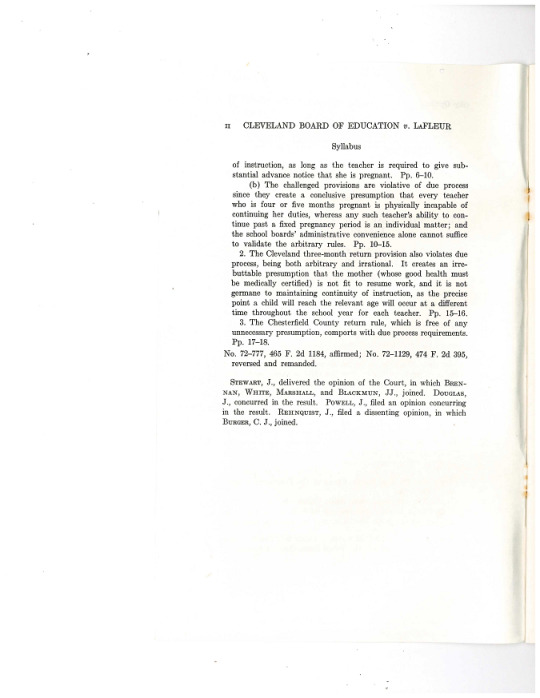
Supreme Court of the United States Syllabus for Jo Carol LaFleur v. Cleveland Board of Education, et al.
Record Group 15: Records of the Department of Veterans AffairsSeries: Case Files of Pension and Bounty-Land Warrant Applications Based on Revolutionary War Service
(slip opinion) - top right: 42 USC § 1983 Public Teachers - Mandatory Maternity Leave, Due Process NOTE: Where it is feasible, a syllabus (headnote) will be released as is being done in connection with this case, at the time of the Court but has been prepared by the Reporter of Decisions for the convenience of the reader. See United States vs. Detroit Lumber Co., 200 U.S. 321, 337. SUPREME COURT OF THE UNITED STATES Syllabus CLEVELAND BOARD OF EDUCATION ET AL. v LaFLEUR ET AL. CERTIORARI TO THE UNITED STATES COURT OF APPEALS FOR THE SIXTH CIRCUIT No. 72-777. Argued OCtober 15, 1973 --- Decided January 21, 1974* Pregnant public school teachers brought these actions under U. S. C. § 1983 challenging the constitutionality of mandatory maternity leave rules of the Cleveland Ohio (No. 72-777), and Chesterfield County, Virginia (No. 72-1129(, School Boards. The Cleveland rule requires a pregnant school teacher to take unpaid maternity leave five months before the expected childbirth, with leave application to be made at least two weeks before her departure. Eligibility to return to work is not accorded until the next regular semester after her child is three months old. The Chesterfield County rule requires the teacher to leave work at least four months, and to give notice at least six months, before the anticipated childbirth. Re-employment is guaranteed no later than the first day of the school year after the date she is declared re-eligible. Both schemes require a physician's certificate of physical fitness prior to the teacher's return. Each Court of Appeals reversed the court below, one holding the Chesterfield County maternity leave rule constitutional, the other holding the Cleveland rule unconstitutional. Held: 1. The mandatory termination provisions of both maternity rules violate the Due Process Clause of the Fourteenth Amendment. Pp. 6-15 (a) The arbitrary cutoff dates (which obviously come at different times of the school year for different school teachers) have no valid relationship to the State's interest in preserving continuity. *Together with No. 72-1129, Cohen v. Chesterfield County School Board et al., on centiorari to the United States Court of Appeals for the Fourth Circuit. [full transcription at link]
11 notes
·
View notes
Text

Attorney Bakari Sellers (September 18, 1984) is a noted attorney, political commentator, and politician. He was born in Bamberg, South Carolina the son of Cleveland and Gwendolyn Sellers. His father is a well-known civil rights activist and leader of the Student Non-Violent.
He excelled in school and attended Morehouse College where he was elected Student Body President. He attended the University of South Carolina Law School where he earned a JD.
While attending law school he ran for the office of South Carolina state representative on the Democratic Party ticket. He became the youngest member of the South Carolina legislature. He was the youngest African American elected official in the US at the time. He served in the South Carolina House of Representatives for the 90th District (2006-14). He served on the Judiciary Committee in the House of Representatives. On June 6, 2013, he announced his candidacy for Lieutenant Governor of South Carolina. Although he won the Democratic Primary, he lost the general election.
He practices law with the Strom Law Firm based in Columbia, South Carolina. He heads the firm’s strategic communication and public affairs team and offers consultant services on the issues of diversity, equity, and inclusion in the workplace. He serves as a political commentator for CNN. He was named to TIME magazine’s 40 Under 40 in 2010, as well as the 2014 and 2015 “The Root 100” list of the nation’s most influential African Americans.
He released his best-selling book, My Vanishing Country: A Memoir, which is autobiographical but tells of his father, Cleveland Sellers, working with Stokely Carmichael and Martin Luther King, and his role in the Student Non-Violent Coordinating Committee which made him a civil rights hero to many.
He released a children’s book Who Are Your People? The book teaches young children about the history of Black Americans and stresses the importance of the Black community in American history and culture.
He has has two siblings. He married Dr. Ellen Rucher (2015) and they have twins. #africanhistory365 #africanexcellence
3 notes
·
View notes
Text
An Ohio man is facing charges after lying about how he suffered injuries, baselessly claiming he was the victim of an anti-Palestinian hate crime, local police said.
Hesham A. Ayyad, 20, of North Olmsted, Ohio, is charged with making false alarms, falsification, obstructing official business, domestic violence and assault, according to records from the Lorain County Jail, which show he was released on bond on Wednesday.
Ayyad was taken to the hospital on October 22 after telling officers he had been hit by a vehicle in a "racially motivated" attack, claiming that he was struck on Cook Road in Olmsted Township near the North Ridgeville border, North Ridgeville police told local media.
Ayyad's claims sparked a Muslim civil rights group to demand that police investigate the alleged attack, according to an October 23 statement by the Cleveland chapter of the Council on American-Islamic Relations (CAIR-Cleveland)
As police investigated the incident, they discovered that Ayyad fabricated the ordeal, the North Ridgeville Police Department (NRPD) said in a statement.
Newsweek reached out via email and social media on Saturday to the NRPD.
It was unclear at the time of publication whether Hesham Ayyad had retained an attorney who could speak on his behalf.
Ayyad initially claimed, according to the CAIR-Cleveland statement, that he was walking home shortly after 4 p.m. on October 22 when a dark-colored SUV approached him. He said the driver rolled down the window and began yelling anti-Palestinian comments at him, including "Kill all Palestinians" and "Long live Israel," before swerving his car. The SUV driver allegedly struck Ayyad, then drove away while shouting, "Die!"
Faten Odeh, interim executive director for CAIR-Cleveland, urged authorities to monitor crimes related to the "rising Islamophobia and anti-Palestinian racism" in the statement issued a day after Ayyad was hospitalized.
The CAIR-Cleveland statement also included a photo of Ayyad appearing to be in the hospital while wearing a neck brace.
"We hope the North Ridgeville Police Department and the FBI will collect all the information they need to charge this individual with a hate crime," Odeh said in the October statement. "We should all feel safe to walk down the street to grab a bite to eat, go to the store, and go to school."
In response to Ayyad's charges, Odeh told Newsweek in an email that CAIR-Cleveland does not have any additional information on the case.
"We are currently seeking more information about this development," Odeh said. "Our understanding is the individual has secured his own legal counsel. We do not yet know anything more about the nature of the charges."
Investigators believe that Ayyad lied, saying that he was never struck by a vehicle nor subjected to racial slurs, but rather he was injured during a fight with his younger brother, who is also facing charges. Video surveillance from the scene confirms an altercation occurred, NRPD said.
His brother, 19-year-old Khalil A. Ayyad, of North Olmsted, was also arrested and charged with domestic violence and assault for his involvement in the fight.
Both brothers are scheduled to appear in Elyria Municipal Court on Tuesday.
17 notes
·
View notes